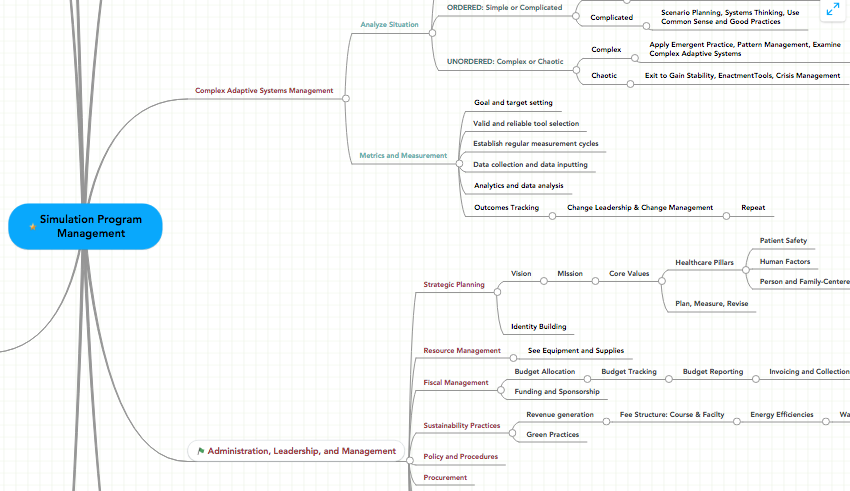Healthcare Simulation Program Management Mind Map Provides Key Needs Breakdown
Today’s helpful resource for those administrating a Healthcare Simulation Program was submitted by Colette Foisy-Doll, Director of the Clinical Simulation Centre at MacEwan University in Edmonton Alberta, Canada. This visual outline of a ‘Healthcare Simulation Program Management Mind Map’ provides us a key breakdown of all the necessary components one must consider for developing or expanding a clinical simulation program, which is available for use online or as a download. As a complementary resource, detailed descriptions and policy and procedure plans for each section and related subsection of the mind map are featured in Simulation Champions: Fostering Courage, Caring, and Connection (Foisy-Doll, C., & Leighton, K, 2018), in chapter eleven, Managing Simulation Program Operations and Human Capital (Foisy-Doll, C). Together the mind map and the book chapter provide simulation leaders with a pathway to Program development that can be easily adapted to align with the needs and goals of specific programs. From Colette:
“A bad system will beat a good person, every time!” ~ W. Edwards Deming, 1993. The leadership lesson gleaned from this quote is the importance of intentionality in building simulation programs characterized by effective structure, systems, and processes. As simulation-based learning continues to evolve, so too has our understanding of what constitutes a simulation program. The Society for Simulation in Healthcare Accreditation Standards defines the Simulation Program, or simply stated, program as, “an organization or group with dedicated resources (personnel and equipment) whose mission is specifically targeted toward improving patient safety and outcomes through assessment, research, advocacy and education using simulation technologies and methodologies” (SSH Accreditation Process, 2017, p. 3). As such, programs must start by articulating overall goals and purpose by crafting a clearly stated vision, mission, and core values, aligning them with those of the greater organization.
The core of all successful Simulation Programs is effective leadership and management practices to lead, manage, and sustain change within organizations and the complex adaptive systems contained therein. At the heart of programs are the key drivers that unite all Healthcare Simulation Programs: quality patient and family-centered health care and improved patient safety and healthcare outcomes. Today, as never before, healthcare educators and practitioners are collaborating to turn the tide on a legacy of patient harm and poor outcomes (Institute of Medicine, 2001, 2013).
Sponsored Content:
When I first started in simulation in the late 90s, it was mind boggling and nearly impossible to conceptualize the various facets that were needed to create a simulation program. Through personal trial and error and shared learning in the global simulation community of practice, we have come to a clearer understanding of what it takes to successfully design and implement successful programs. I first created the Simulation Program Mind Map as a visual aid to facilitate strategic planning and day-to-day operations in my role as Director. The mind map has proven helpful as a framework for strategic planning and priorities and outcomes tracking. A large laminated version of the mind map is hung in our simulation team’s workspace where colored magnets highlight priority initiatives for the purposes of tracking quality improvement initiatives and tracking outcomes.
Note: On the linked website, below the visual MindMap is the digital outline of the MindMap too!
Visit & Download the Healthcare Simulation Mindmap here!
- Foisy-Doll, C., & Leighton, K. (2018). Simulation champions: Fostering courage, caring, and connection. Philadelphia, PA: Wolters Kluwer, Inc.
- Institute of Medicine (IOM). (2001). Crossing the quality chasm: A new health system for the 21st century. Washington, DC: National Academies Press. Retrieved on September 30, 2003 from Institute of Medicine Website: www.iom.edu
- Institute of Medicine (IOM). (2003). Health professions education: A bridge to quality. Washington, DC: Committee on the Health Professions Education Summit Board on Health Care Services.
- The W. Edwards Deming Institute. (2018). The W. Edwards Deming institute blog. Retrieved April 5, 2018 from https://blog.deming.org/2015/02/a-bad-system-will-beat-a-good-person-every-time/
Lance Baily, BA, EMT-B, is the Founder / CEO of HealthySimulation.com, which he started in 2010 while serving as the Director of the Nevada System of Higher Education’s Clinical Simulation Center of Las Vegas. Lance also founded SimGHOSTS.org, the world’s only non-profit organization dedicated to supporting professionals operating healthcare simulation technologies. His co-edited Book: “Comprehensive Healthcare Simulation: Operations, Technology, and Innovative Practice” is cited as a key source for professional certification in the industry. Lance’s background also includes serving as a Simulation Technology Specialist for the LA Community College District, EMS fire fighting, Hollywood movie production, rescue diving, and global travel. He and his wife live with their two brilliant daughters and one crazy dachshund in Las Vegas, Nevada.
Sponsored Content:
Sponsored Content:






















